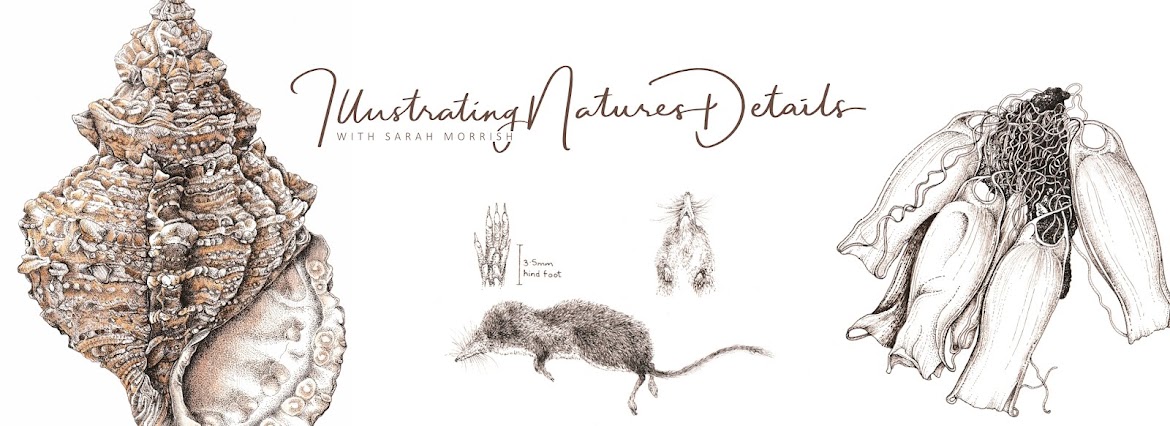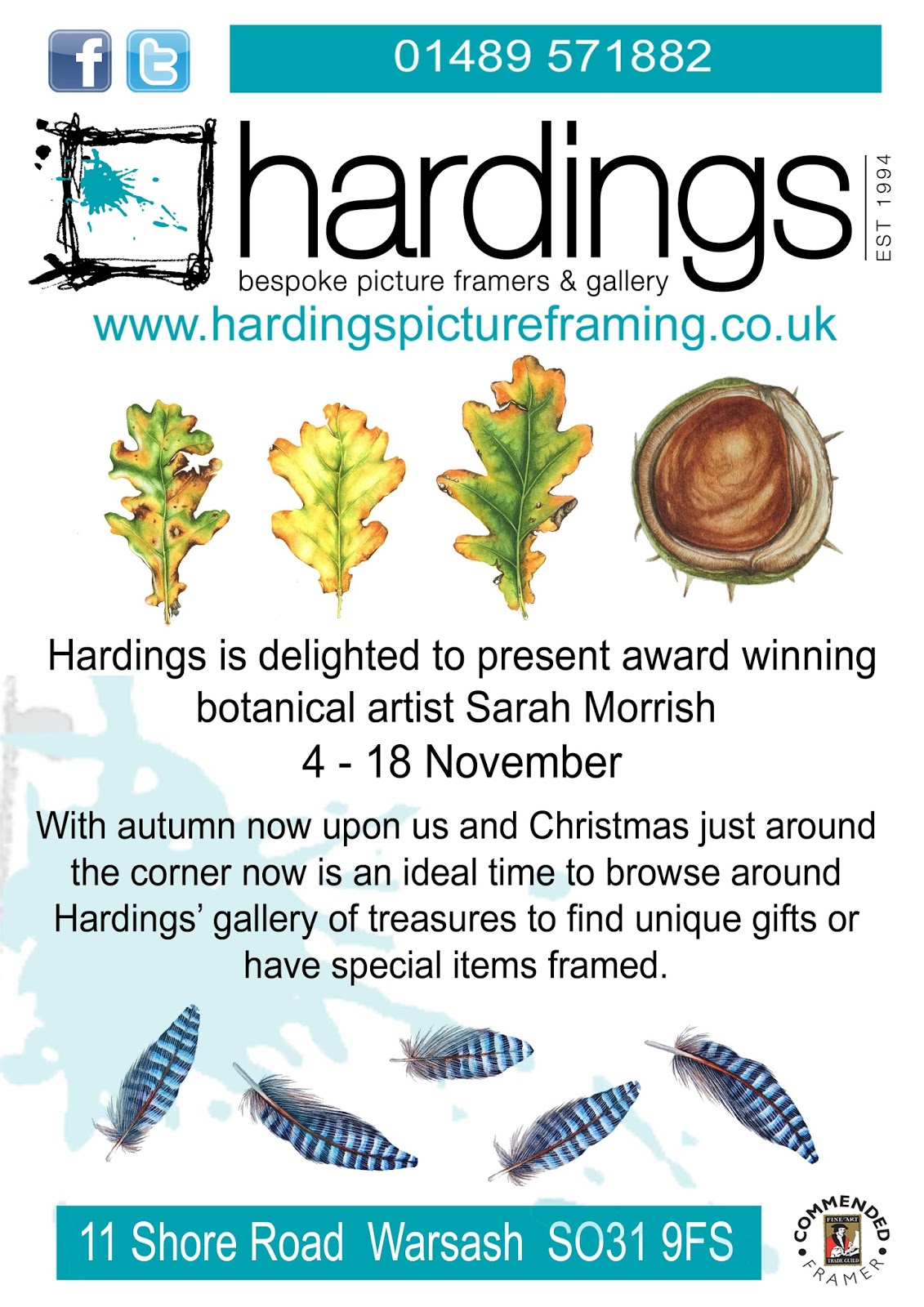I belong to some fantastic art themed groups on Facebook, where we share images of our work, ask for advice, talk about art materials; and one of the things we like most is probably seeing and chatting about what we have in our studios.
Several people have also asked me which Daniel Smith paints I use, so I thought that I would combine this and a few of my favourite things from my studio into a blog post. I hope you enjoy it.
Brush Pots
I always make use of favourite mugs that are of no use anymore for my brushes and pencils, but the three I use most are seen here.
The white mug was my Grandfather's RAF mug from the second world war. He was always a great supporter of my artwork and interest in the natural world, so it is nice to think I have something of his in the room where I seem to spend the most time !
The other two pots/stands have been made by my husband and were some of the first things he made when he took up wood-turning. The tall pot is made of teak, which was quite a tough wood to turn, and the other brush stand is a piece of birch that had seen better days, but I loved the pattern of the grain and the other markings in it.
Brushes
Over time I have used a variety of brushes, but I always come back to my favourites, the Isabey 6228 series. They are made of Kolinsky sable and are of fantastic quality. I find they are very hard-wearing and really keep their points well.
As I am using my brushes all the time and it is hard to keep track of which ones are the newest ones, I try to put a label on the bottom of each saying when I bought them. Hence why it says 'Aut 13' meaning Autumn 2013. The ones I use most obviously wear more quickly and it is easier to tell.
I also love using Rosemary Spotter brushes Series 323. These too are Kolinsky sable.
They are designed to be used for miniature painting, but many botanical and natural history artists use them for rendering fine controlled detail.
Pencil Sharpener
Fair enough, you can't take this pencil sharpener when sketching in the field, it would weigh your bag down a bit ! In that instance I use a scalpel to sharpen my pencil.
This is what I use in the studio and during my classes. It gives a wonderful long point to the pencil.
The advantage to using a sharpener like this is that the sharpening mechanism actually revolves around the pencil. This means that the pencil is not being twisted whilst being sharpened and there is less likelihood the core of the pencil being broken.
Books
I have many botanical and natural history books. Field guides, floras, but also art books on these themes. They are often catalogues from exhibitions, but also include art history books too.
My all time favourite set of books is 'Drawings of British Plants' by Stella Ross-Craig.
What attracts to me these is the clear and detailed illustrations which I so often refer to when illustrating native plants. I may not be illustrating the whole plant, but being able to see what a small botanical feature actually looks like, helps to me understand the true morphology of the plant.
My natural history collection
Much of this I have collected myself or it has been given to me.
I have numerous boxes filled with bits and pieces that I use for my workshops and courses and for my own illustrations or commissions.
My young nieces are mesmorised by it all and have already caught the bug of illustrating nature in their own sketchbooks.
Paints
Last but not least onto the paints ! When I teach I use a limited palette of 6 colours divided into warm and cool colours, but the box on the left is what I call my 'studio box'.
It contains the 6 key colours but also includes other colours that I use when needed, and also some colours by Winsor and Newton, Schminke and Sennelier.
Once my students are confident with the 6 colours and realise the array of colours that they can mix, they too gradually introduce some of these additional colours. It may for example be that they find that they need an alternative to the warm red, or the same for the cool blue.
I must say that my favourite brand of paint at the moment are Daniel Smith paints. They are such smooth and easy to use colours, although when I first used them I soon realised that the you don't need to pick up quite so much colour from the palette with your brush, compared to some other brand of paints.
When I first discovered DS paints a few years ago, I bought some of the Primatek colours. These are colours that are natural mineral based colours and therefore retain the characteristics and quality of the original mineral pigment.
They really lend themselves to painting natural objects and landscapes too. Many of these colours do granulate, which you don't always want I know, but this can be an advantage for particular subjects.
I try to ensure that the paints I use consist of single pigments, but there are a few that that do contain several pigments. These are not colours that I use on a regular basis, but when I do use them I try not to mix them with too many other colours, otherwise it is very easy to end up with a 'muddy' wash.
So if you are wondering about what colours to choose, I thought it a good idea to categorise some of the colours into warm and cool, and in some cases give an equivalent colour.
Cool yellow
Hansa yellow light - a good alternative to a lemon-based yellow
Warm yellow
New gamboge - available in other brands, but this one is transparent
Quinacridone gold
Cool red
Anthraquinoid red - a good alternative to perm alizarin crimson, but slightly richer in intensity
Warm red
Pyrrol red - a semi-transparent colour which is a good alternative to a cadmium red
Perylene scarlet - a vivid red which is also semi-transparent. DS say that it granulates, but I have never noticed this.
The two warm reds above are perfect for painting rose-hips and poppies.
Cool blue
Cerulean blue - the great thing about DS Cerulean blue is that it is semi-transparent. In other brands it is often opaque.
Warm blue
Cobalt blue - the same applies for this colour as for the colour above, it is semi-transparent rather than opaque
Other colours
Other DS colours that I find useful are:
Rhodonite genuine - a very gentle pink
Transparent Pyrrol orange - a vivid rich orange, great for autumnal subjects
Raw umber - a great brown to have in your palette, semi-transparent, but a different colour raw umber than to other brands
Buff titanium - Yes it is opaque, but handy to have for painting fungi and shells
Undersea green - Sometimes I do use ready-made greens, and this is a good one to have. It does granulate, but I found that very useful when I was illustrating a Medlar fruit. The granulation helped to portray the subtle texture of the fruit, especially when the colour was mixed with quinacridone gold.
Sap green - a handy one to have in the palette when you are in a rush for a green ! It works well when mixed with other colours, although you do have to be careful as it is made up of three pigments
Indigo - In the past I have at times steered clear of Indigo as it often contains a black pigment. This one does along with a blue pigment, but an advantage is that it is transparent
Well I must get back to my painting. I'm still working on that fungi painting, which I really do hope I finish this week !






















































